You are enjoying the end of your life with your lover before the sun explodes. You must make time-constrained decisions between looking up at the sky and looking at your lover as you reflect on your last moments.
This story is inspired by my own quiet contemplations of what it means to be in love before you die and what moments matter most to us in a day. I did not want this to be a terribly sad story, but instead a story that makes you reflect on the importance of small actions and moments. Another element of this story that is important to me is that there is equal importance between the interactions that you have with your world and lover and the quiet moments that you have.
To me, spending time with the person you love is often the insignificant moments that add up to form a larger context of a memory. I wanted this game to explore the simplicity of a quiet moment. Rather than guide you to a certain idea of what is the right or wrong way of spending your time, I hoped to give people a sense of reflection on their life. This is also a love letter to the love that I have experienced in my life, which is often quiet, unassuming, and deeply cherished.
Documentation
Ideation
Initially, I had two different stories that I wanted to playtest: a pirate getting turned into a siren and the death of the sun. In this documentation, I describe my process and how I also switched my medium from parser fiction to interactive fiction.
Initial premise: Pirate getting turned into a siren
You are drawing, 1750 ft below water. You try to breathe, but as you swim up you start to drown. As you swim down, it becomes easier to breathe. You notice an abandoned ship. Your goal is to swim back up to shore and figure out who you are. You have a limited amount of time before you are forcibly turned into a siren. You have to figure out who you are and save your crew before you fully disappear.
Initial premise: Death of the sun
Far into the future, the sun is predicted to explode tomorrow in less than a week. Since you live in a small suburban town, the government has only permitted your town to send one individual into space, but your town has 24 hours to decide. You are the youngest eligible individual (18 y/o) to board the spaceship. This makes you the most viable candidate for entry because you have the most life ahead of you. However, there are competing interests among your town for who gets to survive.

Version 1: Role-playing
For the first iteration of my story, I decided to role-play. Although I had a rough outline of the story, I was making most of it up as I went along, inspired by the creative process that I had as a dungeon master when we played collaborative games in class. I felt like I was really stuck in a creative rut, so this was a useful exercise to get my creative juices flowing. I decided to start with my story idea of a pirate getting turned into a siren.
Pros:
- One pro of this story was the idea of a lock and key metaphor. One of the examples that my playtester liked was getting to decide what actions or verbs they could do, for example trying to “breathe” underwater.
- The world-building was starting to form, and there was a shared enthusiasm between me and my playtester building a collaborative world together. This is what initially sold me on the idea of creating a parser fiction.
- They described that their choices mattered in the game because it helped them find and locate hidden objects in this scene.
Cons:
- The story’s motivation was unclear. It was hard to chart the different narrative branches.
- I didn’t have a clear direction for the emotion that I wanted to invoke in the player, and I felt like I was creating without a clear direction.
- My use of space was too sporadic and it was hard to pinpoint where people wanted to move in the story.
- A limitation is that I had to give hints to guide my playtester to a particular direction. While I think that hints can be used effectively, my playtester ended up getting stuck too easily.
Version 2: Escape Room Parser Fiction
I still didn’t have a clear direction from my story, nor was I tied to the idea of doing my siren song story. This was one of the hardest projects I worked on. Thus, I tried to create two different parser fiction stories and test them both on my next playtester, my roommate who had zero familiarity with parser fiction stories. Both games were structured like escape rooms, with rooms that you could explore.
I wanted them to compare the two stories so that I could get a better understanding on which was more effective. This was also inspired by my learnings from my Human Computer-interaction research class, which has taught me about the value of parallel prototyping to generate different ideas in parallel so that you explore more options to prevent fixating on a single idea.
Below is a table of the feedback that I received. A common shared critique between both ideas was that there weren’t enough verbs or actions that a person could take in the space. A limitation I was running into was my technical challenges working with parser fiction that I felt like was also restricting my ability to write productively.


| “You are drowning” | “No one knows when the sun will die” | |
| Pros |
|
|
| Cons |
|
|
Version 2: Key & Lock Parser Fiction
I decided to continue iterating on the idea of the death of the sun. I still structured it as a “key and lock” parser fiction, where the player was unlocking different items and trying to figure out which items mattered. An important design decision I introduced to this version was limiting the number of actions a player could take. I wanted the choices to matter more to the player, and limiting the number of actions made each action feel more important when replayed. I also switched the focus away from being the last individual to escape your small town and more on the relationship between you and your last day on earth. The emotion that I wanted to invoke was a peaceful reflection that teaches the lesson that any way of spending your time is valid, and all moments are meaningful.



The questions that I asked during my playtest were:
- How do you like spending your day?
- What are the most meaningful parts of your day?
- If you only had one day, how would you spend it?
The answer that I got from my playtester that was most insightful was their response to how they would spend their last day. Their response was “That’s like a really hard question. Hanging out with my friends and family if I had only one day. Preferably outside in the warm weather.” The fact that they had difficulty answering that question made me want to explore it further. I informally surveyed my friends and family on how their last day would look like. Most people wanted to spend time with their lover or people they loved, so this motivated me to create a new story to write about that narrative.
Feedback:
- “There’s a lot more that I had to do, but couldn’t do. Actions like taking the locket to your lover should be hinted.”
- Add more dialogue to your lover
- Add to a count when you reach certain items
- “One thing to consider is you should make the things that are really profound at the end of a path so it’s impossible to get them all in 20 turns.”
- “For the experienced user you should make it so you can achieve it in the minimum amount of turns.”
- They tried unwritten commands like “Return library book, Sit on the grass / lie on the grass, Kiss lover, Look at sky”
In my playtest, my playtester replayed my game 4 times, but I noted most of these replays were related to frustrations with their turns even though they were an experienced parser fiction player. I also used the actions they suggested to ideate on possible storylines to include in my game.
Version 3: Limited Turn Parser Fiction
Based on their feedback, I decided to continue experimenting with limited turns. I completely redrafted my story, this time making sure that the story could be completed with a limited amount of turns for the narrative arcs that I wanted to try. I also thought it was interesting from my last playtest how my playtester kept trying to look at their lover or look at the sky.
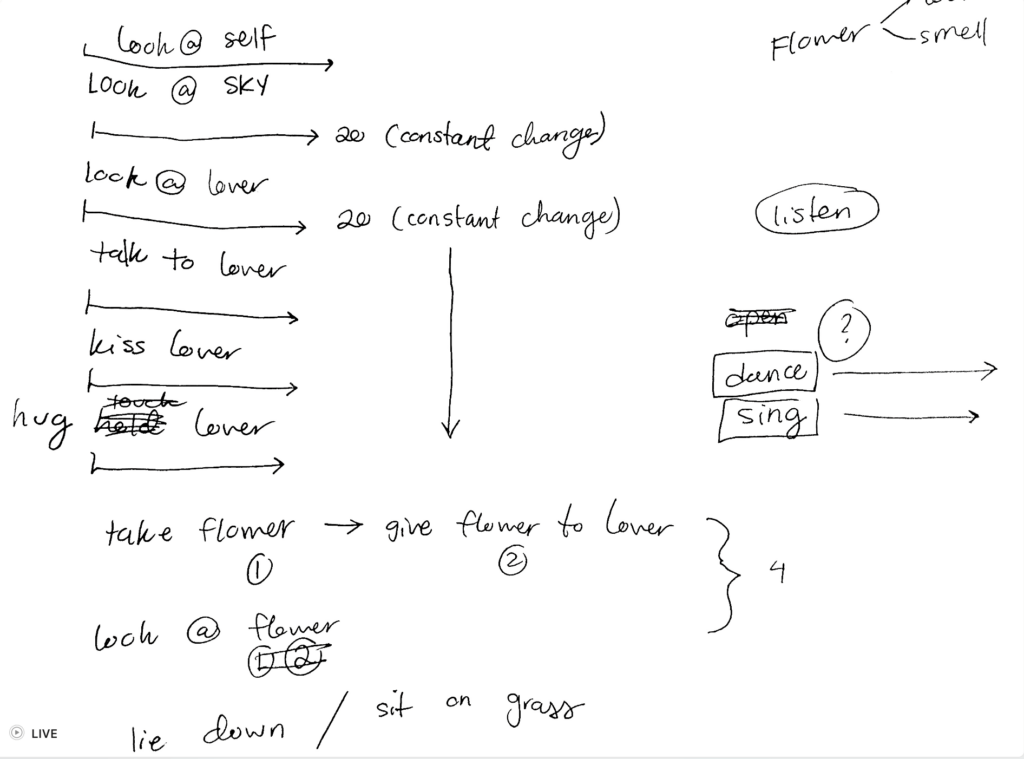
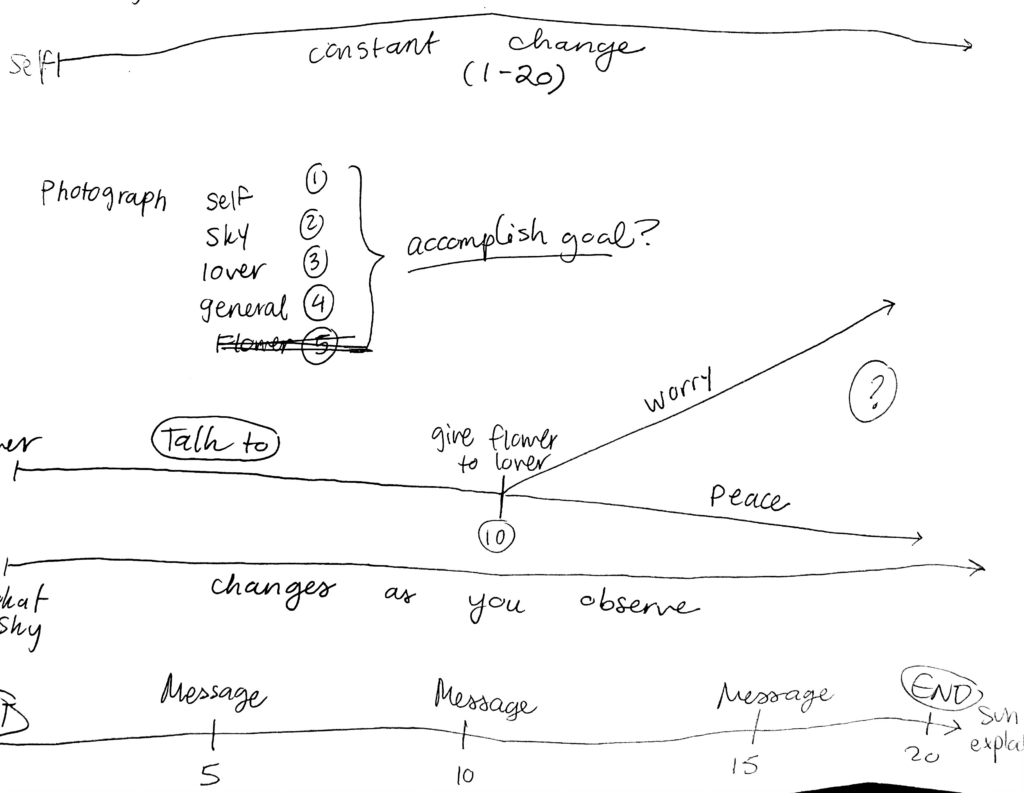
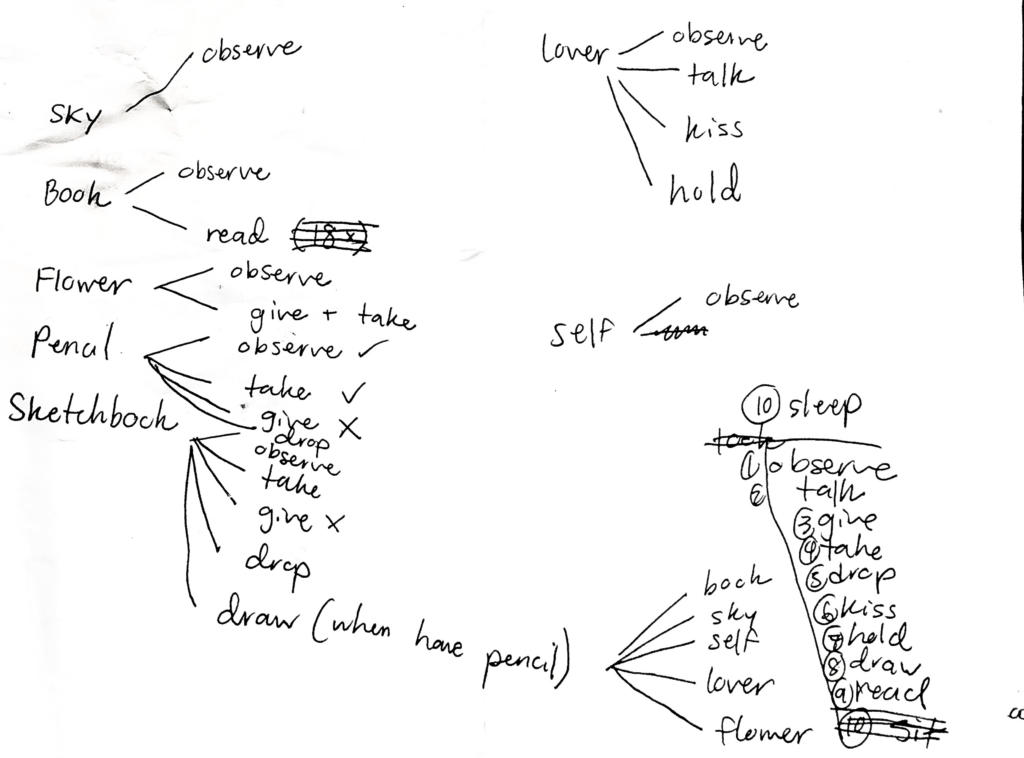
I made that the next premise of my story. Each time they looked at their lover or the sky, their lover or sky would change and reveal another part of the story.


I decided to playtest this iteration with my friend who had never played parser fictions before.
Feedback:
- They wanted other options than just looking at the sky or the park
- They kept getting stuck in parser fiction and didn’t know what to do next
- They wanted more choices that were clear and defined
- They tried commands like “sing”, “wonder”, and “reflect” that I didn’t have
Overall, I felt like while this playtest was rough and ready, it was also illuminating to me the different choices that my playtester made when she had a limited number of choices and turns. I thought that this was a worthwhile exploration, and I decided to keep exploring different ways to tell this story because I felt like parser fiction wasn’t the most impactful medium for what emotions I wanted to share. People were getting stuck on the frustrating nature of the game rather than focusing on the story itself.
Version 4: A switch in mediums

To validate my game, I decided to test it in three different ways. My playtester was experienced with both playing branching IF games and parser fiction, making them a lucky candidate to compare and contrast my different ideas.
- Version 1: Multiply-branched interactive fiction on Twine. In this version, the storyline is less clear, but you have more “exploration” that you can do in the game itself to explore the lover’s past.
- Version 2: Two-branched interactive fiction on Twine that converges in one ending. You choose between looking at your lover vs. looking at the sky in a game of 8 turns before the sun dies.
- Version 3: Parser fiction version (same as previous version)
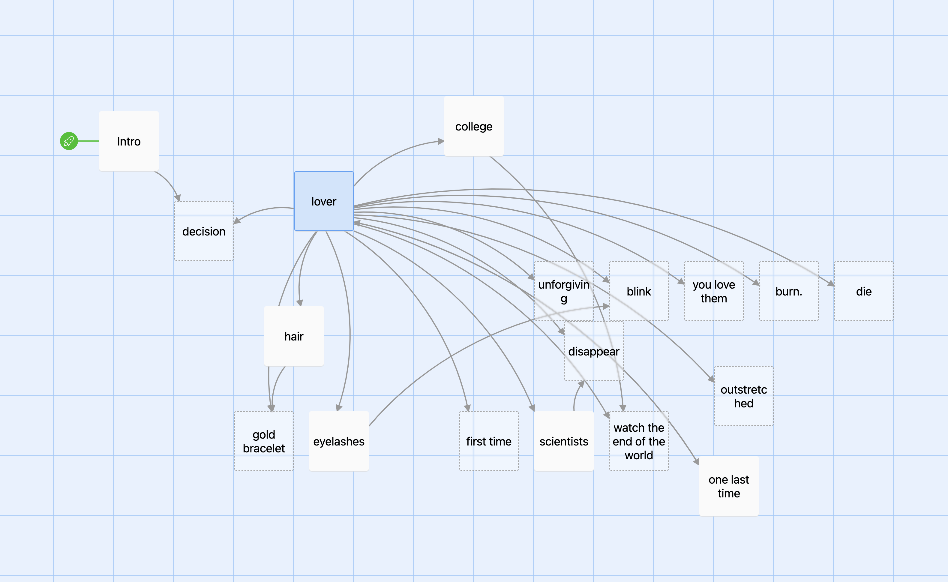
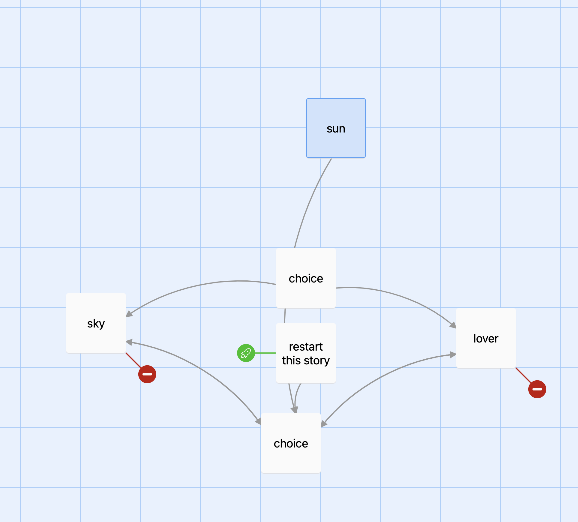

| Version | Feedback Highlight |
| Version 1 | “I was really intrigued by the premise. I felt rushed. I need to make decisions really quickly. When I was making choices. I was trying not to look at my partner, cause I thought something bad would happen. I don’t think I actually looked at my partner. If I were to play this again, I probably would look at my lover first.” |
| Version 2 | “Comparing the [first to the second], there were more options that you can look at on one page. This one felt more balanced. The second feels like I have more control, the first one more variable, this one feels more linear. It feels like my decision is fatal. If there’s only so much time, then I have to make a decision as I imagine laying on the grass.” |
| Version 3 | “ I like parsing – I just didn’t know which verbs I could use. In the original one, I liked how if I looked at things, I liked the level of detail to give me options”. |
Based on their feedback, I decided to switch mediums to version 2: a two-branched interactive fiction on Twine that converges into one ending. My key reason was that they pointed out the “fatality” of a decision in version 2, which matches the story that I wanted to portray. Because I wanted to make the time you spend before you die in my game more impactful, I think it made sense to make these decisions more deterministic. One positive was that I was (finally) achieving the emotion that I wanted to create, which was aided by the sense of urgency I built in my game through the mechanics of limited turns.
Version 5: Branching narratives
I decided to rapidly iterate in the next 20 minutes after my last playtest, and I created a new version. This time, I added a timer to my game so that you had a diminishing amount of time (5 seconds) that forced you to choose your next action. If the player didn’t advance, then the decision would be automatically made for you.
Feedback:
- “I’d like there to be some impact.”
- “The decisions in the last moments really matter.”
- “If they all end the same, the game doesn’t respond to my decisions.”
- “It might be good to have some sense of discovery, and some storyline that you’re investing in. Otherwise it’s just 8 flashes of scenes. It just feels like the same thing.”
My playtester helped me realize that I need to work on my storyline more. I also had to make the decisions at the end feel more impactful. A change I decided to make was to make multiple versions of an ending depending on how many times you looked at the sky vs. your lover. I also decided to build some more of the narrative, adding more passages to my story to show more interaction between you and your lover.

Version 6: Final Iteration
After my last playtest, I continued to develop the story. I playtested on three different people after, all of which who were not familiar with interactive fiction. Based on their feedback, my game seems like it has achieved its target goal and emotions.
Feedback:
- “I’m just so blown away with how beautiful n its story and smplicity”
- “I love how clicking on links is like focusing your attention on those attributes of the sky or your partner. It’s such a wonderful parallel.”
- “I love that the game has different lengths based on how you progress through it. I like how if you keep looking at the sky, you’ll have how much ever time you want, but if you look at your lover, time starts to pass in those moments.”
To add to the theme of my game, I added custom CSS to make the background appear like the colors of a sunset.
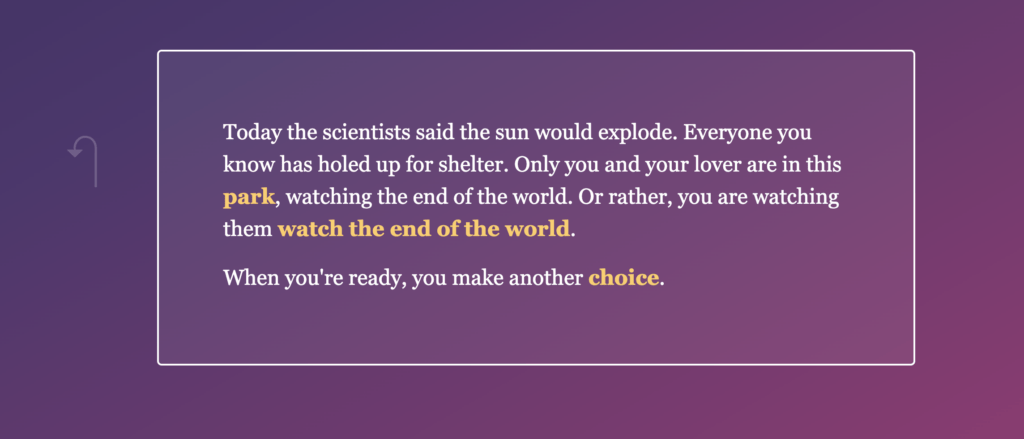
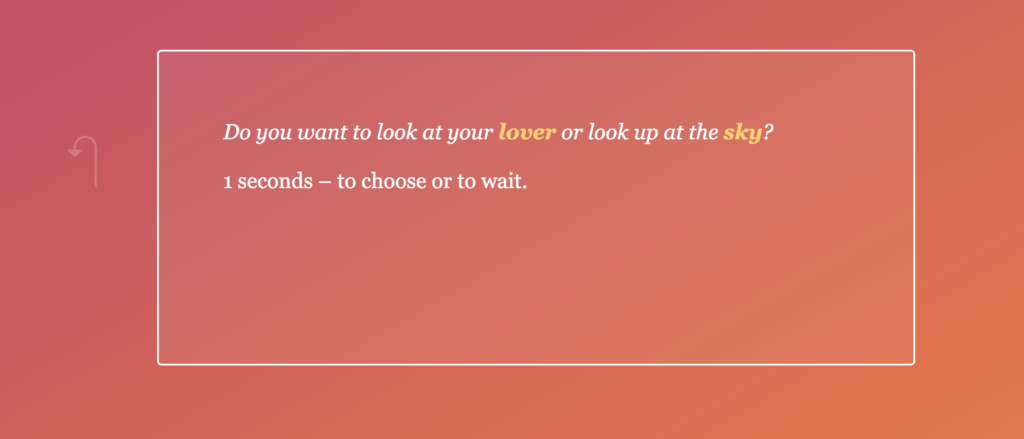
Reflection
What I did
I started with two ideas and parallel prototyped them to learn about interactive fiction in the forms of a branching narrative and parser fiction. I also parallel prototyped my final story idea in multiple formats, which helped me gain an appreciation and understanding of the limitations and benefits of different types of storytelling. Through (a lot) of playtesting, I could see the direct effects of my story and structure on the emotions of my playtests.
It was easy to be self-critical throughout the process as I struggled to build my game. However, I learned how to test fast and test often, making iteration after iteration to build the final version of my game. I also tested multiple types of story formats (escape rooms, fixed story, parser fiction) – all of which taught me different techniques for storytelling that I would love to implement in future games.
What I learned
I learned about the value of iterative testing. I had many “failed” versions of this game, and it was easy to feel discouraged when I didn’t get the exact feeling that I wanted to portray from my playtests. However, testing different versions of my game helped me validate my assumptions. They also challenged me to design out of my comfort zone and truly evaluate what a “good” game is as I sought to achieve the sense of reflection I was seeking in this game.
I also learned more about what it means to tell a good story. Having a great story can propel a player forward. Prior to this class, I have not recently done a lot of creative writing, so this class challenged me to write more and reflect upon my writing.
I have never done a solo game design project. It was both freeing and daunting to have creative control over my game’s choices and decisions. However, what I learned from this experience is the parts of the design process that I enjoy – testing, iterating, and visual design. I think that this has served me well to guide me to improve the other parts of my design process that I feel technically weaker in, like narratology.
What I would do differently
If I were to reapproach this project, I would start with a more clear story arc for my characters. This project was difficult because I was often stuck on the implementation of my storyline. I had ideas on how I wanted the story to feel and the experience, but writing is not my strong suit. Thus, I would have spent more time developing the narrative before I tried testing it in Inform or Twine.
I also would have done more paper prototypes as well. I often got stuck on the technical documentation and didn’t test early enough in the beginning of my project, so I would not jump to create a digital version before my story was truly ready. I’ve appreciated analog testing a lot more since building this game, and I think it would have also saved more time for me in the development process if I had a clearer plan of my story before I moved forward.


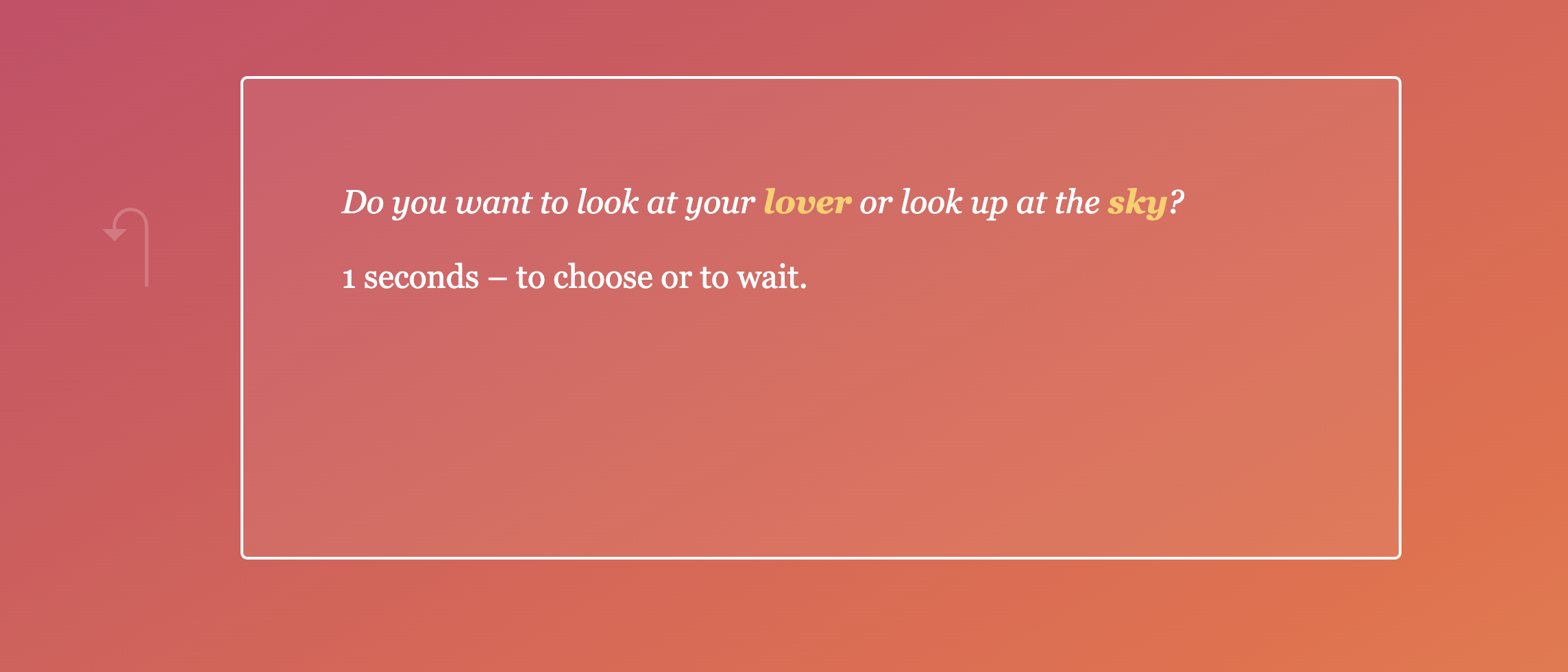

This game is a warm invitation for players to reflect on what they would want to do at the end of the world. The values I see in this game is an appreciation of the quiet, slow moments in life. There’s something very beautiful and compelling about the sense of slowness you’ve created through the slowly changing warm background color and the voice/tone of the language. The slow contemplation doesn’t make the player feel rushed even though the story is that the world is ending soon. There’s also a value of appreciating the wonder and might of the Sun and nature through the details of how you describe the Sun.
After reading your documentation, I believe you succeeded in getting your learning goals across. Again, you’ve beautifully managed to evoke the sense of time slowing down and of appreciating and reflecting in your thoughts when something big happens. I really appreciated the small details you put into each passage. The language is beautiful and added to the ambience of slow reflection. I really enjoyed that the passage you get after making the choice to look at your partner or the sky changes every time you make that choice. I hadn’t expected that so it made me want to play again and again to find out all the passages. I think the branching narrative medium fit the goals you had. I also liked that you had the ability to wait and not make a choice between the sky or your lover. It made it feel less stressful and added to the ambience of slow contemplation.
I wasn’t clear on the difference between choosing to look at the sky or the lover since the descriptions for both seem to lend towards the same types of descriptions. It seemed that choice is really important but the end results are really similar and maybe that is something you wanted to show in your story but if not, I was a bit confused by that.
The visuals pair very well with the content of the IF. The color-shifting background reminds me of a sunset and makes the experience very relaxing to look at. You picked a very poetic premise and the florid, descriptive tone of the writing matches it. When I first played it I chose to look at the sky every time and I liked it. When I looked at the lover there was a lot of intense emotions and I felt scared (maybe more of a me problem). I like the story’s perspective on living a rich and meaningful life, no matter how long or short a time you have.
I think this IF did what it set out to accomplish: illustrate a tragic, beautiful, and fleeting moment.
I experienced no bugs.
The game was built around choosing to look at the lover or the sun, so I think the medium is honored.
It is evident from the documentation that the game evolved drastically from its initial ideation based on playtester feedback.
The game had meaningful choices because there is nothing more meaningful than choosing what to appreciate in the present moment.
The most dominating value I found in the game is mortality. The impending and unavoidable death of the sun forces the player to contend with their own temporariness. Every choice the player makes in the game is objectively banal; the player simply chooses what to look at. The pure banality of this choice reflects the value of mortality. When any moment can be your last, the subtle beauty garnered from the human gaze, aesthetics, becomes the objective for living. In a way, the world of “The Last Moment of the Sun” presents the player with an extreme lack of choice. Whatever they choose to do, they will die regardless. Such a futile world provides no meaning to life, thereby forcing the player to find meaning in the most common of moments.
The IF forces the player to “think in the moment” and “enjoy the little things;” ideas that enrich one’s everyday life. Personally, I try to practice this (being present) as much as I can, but sometimes we get wrapped up in things. In any case, the game does a good job of getting you to care about living a present and contemplative life.
The game used the medium very keenly to present the story. By forcing the player to make such simple decisions, it highlights the importance of contemplation and aesthetic appreciation. An interesting twist on the medium to say the least.
Personally I wanted to look at the exploding sky and as I write this I am taking frequent glances at the sunset out the window of my room. This is to say the choice was obvious and I looked at the sky every time. However, I think that’s a me thing and the game does a good job of making the choice of what to look at interesting.
I was worried this might be derivative but you found your voice and made this story distinctly your own. It was interactive poetry! Nicely done.